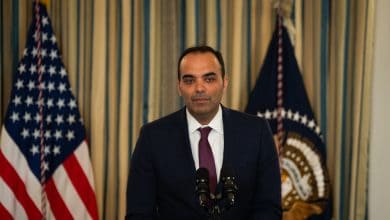In a Shaky Oil Market, OPEC Has Bitter Decisions to Make

These are tricky times for the world’s major oil producers: Prices are lower, the health of the global economy is uncertain, and, even as the Organization of the Petroleum Exporting Countries tries to cut output, supplies from other producers, notably the United States, are growing.
No wonder the group postponed its year-end meeting. Initially scheduled for last weekend in Vienna, the meeting is now planned for Thursday, barring another postponement. The agenda — whether to cut production further, and by how much — is likely to be unpalatable for many of the 23 members.
The price of Brent crude, the global benchmark, has fallen to about $82 a barrel, from a high of more than $96 this year and $128 at its height early in the Ukraine war.
It has dropped even as producers in OPEC Plus, a bigger group that includes Russia, have cut production, but the coming months seem unlikely to give oil producers a respite from this squeeze.
After three years of pandemic recovery and robust increases in demand for oil, appetite is expected to slow in 2024. The main reasons: China, which accounted for three-quarters of global demand growth in 2023, is facing an economic slowdown. Overall economic expansion is expected to be tepid while more efficient energy use and increasing numbers of electric vehicles reduce oil consumption. With production expected to increase outside of OPEC Plus, there will be little need for increased output from the producers group in the early part of 2024 or, perhaps, longer, analysts say.
The weak market is pressuring Saudi Arabia, the de facto leader of OPEC Plus, to push to continue and perhaps even deepen production cuts. Saudi Arabia and Russia, for instance, may roll over into the new year the trims of one million barrels a day and 300,000 barrels a day that they agreed to last summer. Russia’s cut applies to its exports of oil.
Some smaller OPEC producers, including Nigeria and Angola, are being asked to sign off on lower production limits that are more reflective of their recent output history, while the United Arab Emirates has received a higher level.
“There is a good chance the group will agree to some sort of additional cuts,” said Richard Bronze, head of geopolitics at Energy Aspects, a research firm.
At the same time, analysts forecast that drilling in countries like the United States, Guyana and Brazil — which are not members of OPEC — is likely to increase output enough to meet the additional global oil consumption that emerges in 2024 and, possibly, in later years.
The International Energy Agency projects that global demand will increase by a modest 930,000 barrels a day, an amount that could easily be covered by increases by producers outside of OPEC Plus.
Amid the squeeze on OPEC, the United States is thriving as an oil producer, accounting for 80 percent of the global supply increase in 2023, according to the I.E.A. In October, the United States pumped 19.8 million barrels a day, close to the combined total from Russia and Saudi Arabia, the next two largest producers.
Operators outside OPEC generally have an interest in producing oil rapidly to recoup their investments and earn profits.
“The pipeline of non-OPEC projects alone appears sufficient to meet all global demand growth in the next few years at least,” analysts at Morgan Stanley wrote in a recent research note.
Iran — an OPEC member that is exempt from cuts because its oil exports have been subject to Western sanctions — is adding to supply. Thanks to what analysts say is loosened enforcement of those sanctions, Iran has increased output 30 percent to 3.1 million barrels a day since 2021, according to figures from the producers group.
Of course, events could scramble forecasts. The picture would look very different if the now-suspended fighting in Gaza spread to the wider Middle East, which has some of the world’s largest producers around the Persian Gulf along with sea lanes that carry their oil to customers.
For now, though, oil traders see little chance of a wider conflict.
OPEC’s leverage over the markets is weakened when non-OPEC countries are in a better position to meet growing demand. OPEC Plus was forced into a series of cuts over the last year to prop up prices and to avoid a buildup of oil reserves in tank farms.
Reducing production helped lift prices above $90 a barrel for benchmark Brent crude in September, but OPEC Plus has paid a price in lost sales. The Saudis, who have taken the brunt of the cuts, are producing just nine million barrels a day, nearly two million below levels of a year ago.
These cuts are also diminishing the oil earnings that are key to Saudi Arabia’s government budget and its ambitions to invest in businesses not linked to oil, including the LIV professional golf tour and Newcastle United, a soccer team in England’s Premier League.
This month, for instance, Saudi Aramco, the national oil company, blamed lower oil sales in part for a fall in net income of 23 percent in the third quarter, a drop of $10 billion, from a year earlier.
“We are getting not far from the point where quotas are becoming unrealistically low,” said Gary Ross, chief executive of Black Gold Investors, an investment company.
Saudi Arabia is not the only producer being squeezed. Abu Dhabi, the oil power at the core of the United Arab Emirates, has brought in international partners to lift its production capacity to five million barrels a day, yet is required to hold output to 3.2 million under the quota established in June for 2024.
For now, analysts say, OPEC’s members appear to be trying to stick together. After all, $80 a barrel ispreferable for producers to the market collapse that could result if the Saudis fully opened the taps, as they did most recently in 2020, when prices fell more than 9 percent in one day, to around $45 per barrel.
Not reaching an agreement is “a risk that OPEC Plus cannot afford to take,” said Homayoun Falakshahi, an analyst at Kpler, a research firm.




